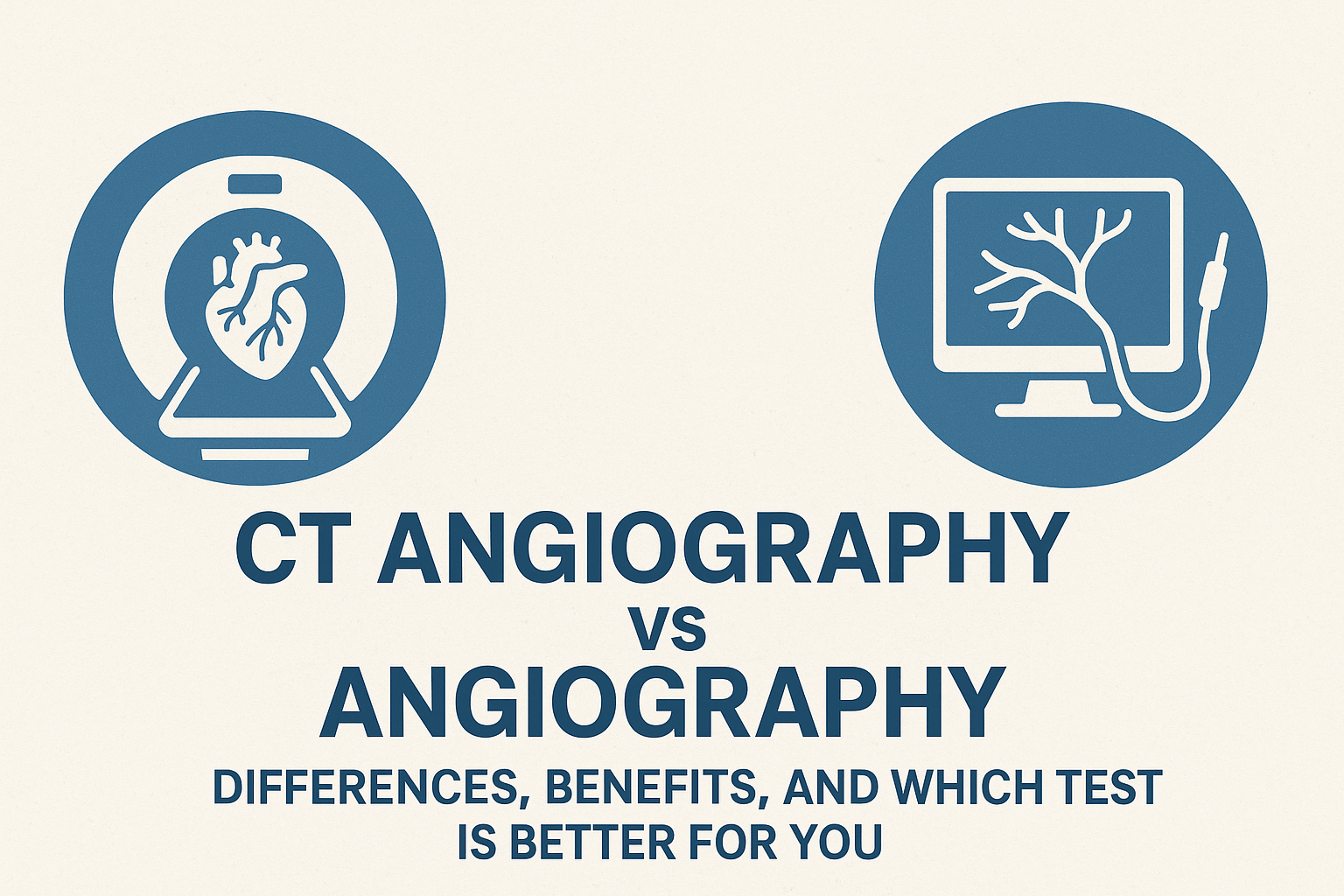
CT Angiography vs Angiography: Differences, Benefits, and Which Test is Better for You
- Category: Health Awareness
- Date 24-09-2025
Two popular imaging tests are typically suggested when diagnosing cardiovascular and heart issues, including CT angiography and conventional angiography. The decision to take either or both options may overwhelm the patients. Is it better to do a non-invasive CT scan or do it in the traditional catheter-based method?
In this blog, we will examine the difference between CT angiography and angiography, describe the differences between these two tests, discuss the advantages of using CT angiography, and discuss the situations under which each test is advised. At the end, you will clearly know which procedure may benefit your condition the most.
What is Angiography?
Angiography is a medical procedure used to aid doctors in visualizing the blood vessels and evaluating the flow of blood in those vessels. Blood vessels are not visible on your regular X-ray, so a special dye (contrast agent) could be injected into your bloodstream to indicate them.
The test is considered especially helpful in detecting:
- Atherosclerosis (narrowing of the arteries as a result of cholesterol)
- Angina or chest pain from poor blood supply to the heart
- Pulmonary embolism (blockage in lung blood flow)
- Peripheral arterial disease (poor blood circulation in the limbs)
- Brain aneurysms (bulges in brain arteries)
- Kidney vessel blockages
Traditional angiography procedure:
- Patients are treated with sedative medicine, but they are awake.
- The opening is small, typically around the point of the groin or wrist.
- A catheter is placed in the artery and leads to the target site.
- An injection of contrast dye is performed, and X-ray images (angiograms) are made.
Although useful, angiography is not only invasive but also has the risk of bleeding, infection, and artery damage.
What is CT Angiography?
|
Aspect |
CT Angiography |
Traditional Angiography |
|
Invasiveness |
Non-invasive (IV line only) |
Invasive (catheter inserted) |
|
Procedure Time |
20–60 minutes |
Usually longer |
|
Comfort |
Painless, minimal discomfort |
May cause pain/discomfort |
|
Accuracy |
Highly accurate for diagnosis |
Gold standard, especially when surgery is needed |
|
Risks |
Minimal (low radiation, rare contrast reaction) |
Bleeding, infection, artery injury, stroke |
|
Best Use |
Initial screening and diagnosis |
Confirming severe blockages and enabling angioplasty |
CT angiography is a non-invasive and diagnostic procedure that can be completed within a short time, whereas conventional angiography can lead to rapid treatment options, such as angioplasty or stent placement.
CT Angiography vs Angiography – Which is Better?
The decision is made depending on your health status:
- CT angiography is generally the first option for a quick and safe assessment of blood vessels when required by the doctor.
- If the test shows significant blockages or narrowing, then a follow-up with conventional angiography might be done.
- In the case where an intervention (such as angioplasty) is expected, a conventional angiogram is favored since doctors can diagnose and treat in a single visit.
So, when it comes to the difference between angiography and CT angiography, which is better, the answer is dependent on your diagnosis requirements. Both tests are complementary rather than competitive.
Advantages of CT Angiography
The benefits of CT Angiography are many, especially for patients who want something less invasive. Some of the main advantages of the CT angiography include:
- Non-invasive: No catheters are to be placed; only an IV line.
- Fast: It obtains detailed 3D images in little time.
- Painless: There is no extra pain during or after the test.
- Comprehensive: It can examine a number of areas in the body, including the heart, brain, and lungs.
- Safe: Little exposure to radiation; there is no radiation left in the body.
Risks and Considerations
As with every medical procedure, both angiography and CT angiography pose some inherent risks.
Angiography Risks
- Bleeding or infection at the catheter site
- Allergic reaction to dye
- Damage to the artery
- Rarely, a stroke or a heart attack
CT Angiography Risks
- Low radiation exposure
- Possible allergic reaction to contrast material
- Not always appropriate for people suffering from kidney issues.
Your physician would consider your medical history, signs and symptoms, and any risk factors with regard to deciding the most appropriate test for you.
Why Choose Lifetron Hospital for Angiography Services?
At Lifetron Hospital, our Radiology department is equipped with the latest CT scanners and digital angiography suites to carry out precise investigations. Cardiologists, pediatricians, geriatricians, and diabetes care specialists (obesity, hypertension, and related ailments) ensure personalized care for each patient.
Whether it is a cardiac CT scan vs angiogram decision, or an elaborate malignancy workup, our specialists can guide you to the safest and most efficacious solution.
Conclusion
When considering CT angiography vs angiography, remember that both are crucial for diagnosing heart and vascular conditions. While CT angiography is fast, painless, and non-invasive, traditional angiography is considered the gold standard for the diagnosis and treatment of significant blockages.
Your doctor will choose the best option based on your own medical condition, symptoms, and treatment objectives.
For better heart health and vasculature, talk to Lifetron Hospital today, and let our expert doctors guide you along the safest and most effective diagnostic path.
